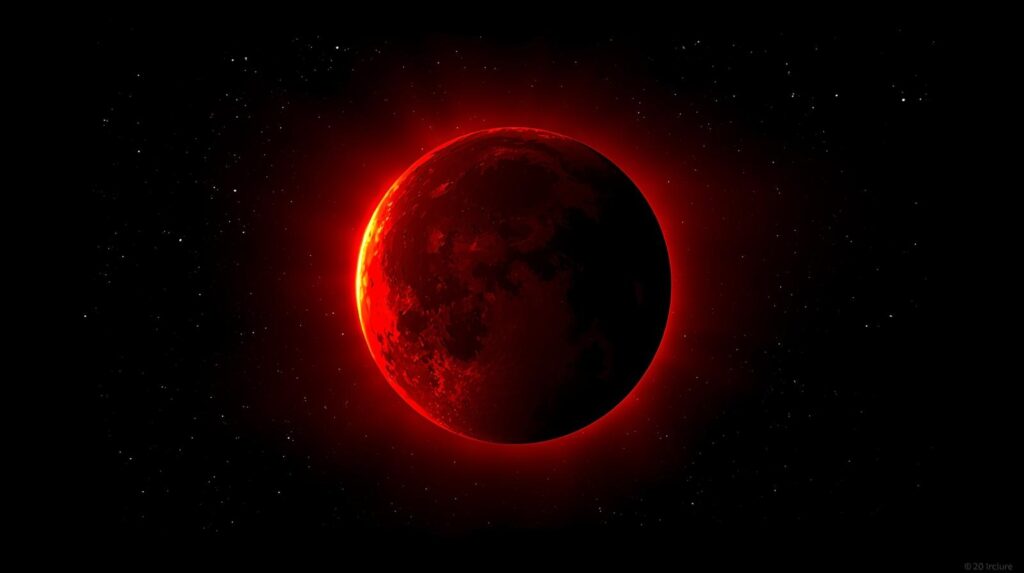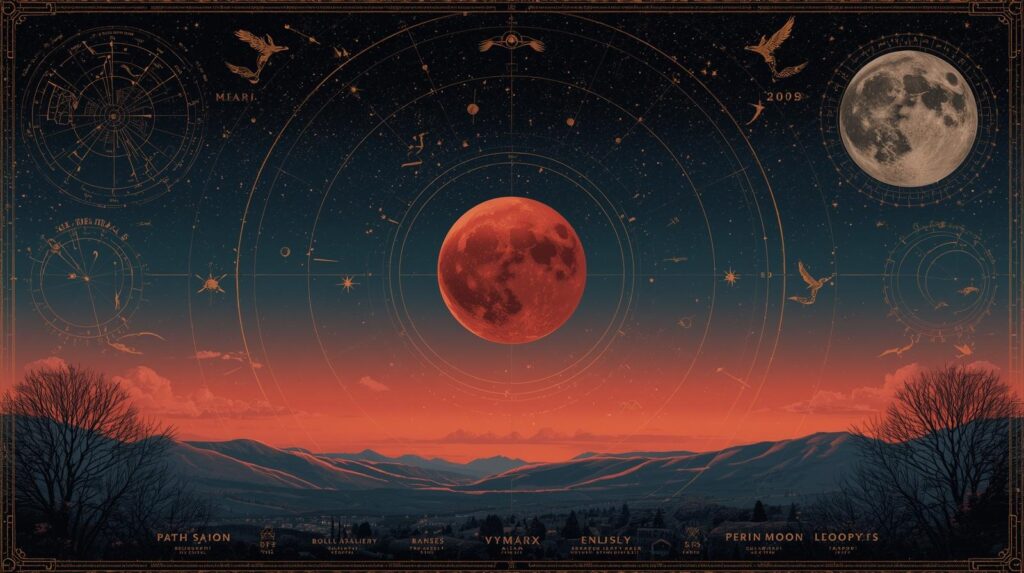How to See Sunday’s Blood Moon Total Lunar Eclipse
Clear your skies, stargazers! Sunday evening, September 7-8, 2025, the night sky is gifting us with a breathtaking sight—a total lunar eclipse, or Blood Moon. That’s when the Moon turns a cool, reddish hue because the Earth’s shadow blocks sunlight. It’s like the universe is painting the Moon red for a brief moment, and it’s totally free to watch!
Whether you’re an inexperienced skywatcher or have a telescope at the ready, this guide will walk you through how to see this beautiful event. We’ll explain when it happens, where to look, and some tips for making it one to remember. Thanks to the efforts of persons like NASA, TimeandDate.com, and the Virtual Telescope Project for tracking these events, we now have all the information you would want to have fun with the Blood Moon in an easy, entertaining way.
What Is a Blood Moon?
Why the Blood Moon? A lunar eclipse is created when Earth exactly positions itself between the Sun and the Moon, placing a shadow around the Moon. At a total lunar eclipse, the Moon passes completely into Earth’s dark shade, the umbra. Instead of growing pitch black, the Moon reddens or orangifies. Why? The Sun’s light is refracted through Earth’s atmosphere and the blue light scatters away, leaving only the red light to illuminate the Moon. It’s the same reason sunsets are red and fiery. That’s why humans call it a Blood Moon—it isn’t scary, but rather nature doing something very cool.

Sunday’s eclipse is a whopper. It’s the second and final lunar eclipse of 2025, stretching over five hours long, with the red Moon shining bright for close to 82 minutes. It’s one of the longest total eclipses in years, so it’s a great chance to see something really unique. Everyone’s all over it online, talking about ideas and getting ready to watch it together.
When and Where to Catch It
Timing is everything with an eclipse, and location is also significant. The Blood Moon will occur between September 7 and 8, 2025, starting at 11:28 a.m. ET (15:28 UTC) and ending sometime before 4:55 p.m. ET (20:55 UTC). The climax, or totality when the Moon is fully red, will occur from 1:30 p.m. ET to 2:52 p.m. ET (17:30 to 18:52 UTC). A quick breakdown of the agenda follows:
Penumbral phase (Moon starts dimming a bit): 11:28 a.m. ET (15:28 UTC)
Partial eclipse (Shadow starts covering the Moon): 12:27 p.m. ET (16:27 UTC)
Totality (Moon turns red): 1:30 p.m. ET to 2:52 p.m. ET (17:30 to 18:52 UTC)
Partial eclipse ends: 3:54 p.m. ET (19:54 UTC)
Penumbral phase ends: 4:55 p.m. ET (20:55 UTC)
If you’re in Asia or Western Australia, you’re in for the full show—every stage will be visible. Folks in Africa, Europe, eastern Australia, and New Zealand can see parts of it, especially during moonrise or moonset. For example, in the UK, the Moon rises around 7:30 p.m. BST, so you’ll catch totality and the later phases. In Cape Town, South Africa, totality is from 7:30 p.m. to 8:52 p.m. local time, and in Sydney, Australia, it’s early evening. Sadly, if you’re in America, the Moon will be below the horizon, so you’ll miss it live. But don’t worry, there are fantastic livestreams that will keep you informed.
Get your moonrise time in your area on TimeandDate.com to plan your viewing. Tweets on social media on X are already posting accurate times for places like London and Tokyo, so you can check there too for news.
How to Watch the Blood Moon
The good news about a lunar eclipse? You don’t need fancy equipment. It’s 100% safe to look at with your naked eye, as opposed to a solar eclipse when you need special glasses. Here’s how to get the best view:
Select a Location: Select a location that has a clear view of the sky, especially towards the rising of the Moon in the east. A park, a hilltop, or even your own backyard would do. Avoid city lights or skyscrapers blocking the Moon.
Check the Weather: Clouds might ruin the view, so have a look at your local weather forecast. In places like the UK, the eastern parts might have better prospects for clear skies. Keep tabs on updates as Sunday looms.
Bring Gear (If You’d Like): Your own eyes are fine, but binoculars or a small telescope will make the Moon’s craters and red light come alive. In photos, a cell phone camera might suffice, but bring a DSLR 200mm lens or larger for sharp shots. Use a tripod to stabilize it.
Time It Right: Plan ahead before moonrise where you are. In the UK, that’s around 7:30 p.m. BST for totality. In Asia, you’ll see the whole show in the evening. Put an alarm on so you don’t miss the red Moon.
Make It a Party: Invite a few friends over, pick up a blanket, and some munchies. Maybe put on some relaxing tunes or learn some cool facts about the Moon. Some folks thought that a Blood Moon was being devoured by a dragon—nuts, right?
If you’re in the Americas or clouds block your view, tune into a livestream. The Virtual Telescope Project in Italy is streaming on YouTube starting at 1:45 p.m. ET (17:45 UTC). Space.com will have a live blog with photos and updates from viewers worldwide, which is trending on X right now.
What You’ll See in the Sky
The eclipse starts off with the penumbral phase, where the Moon is partially darkened—isn’t really noticeable, so you might not even see it. Then comes the partial phase, and it looks like a piece of the Moon has been bitten out of it. For totality, the whole Moon is red or coppery orange. The color shifts—once it’s a burning red, other times a richer, reddish color, depending on dust or clouds in the Earth’s atmosphere. It is as if the entire world’s sunsets are lighting up the Moon.
Totality lasts 82 minutes, and you have time in abundance to view it. The Moon then slowly shines with increasing light as it comes out of the shadow of Earth, regaining its usual silvery glow. The whole process takes 5 hours and 27 minutes, and even if you miss the start, you can view the later stages.
Why This Eclipse Is a Must-See
A Blood Moon is more than a clean sight—it’s a chance to observe the Earth, Sun, and Moon line up perfectly. It’s sort of like receiving little reminder of how amazing our solar system is. Dr. Edward Bloomer from the Royal Observatory Greenwich puts it perfectly: “You’re watching something real, not a movie effect.” This eclipse is extra special because it’s one of only two in 2025, and the next total lunar eclipse isn’t until March 2026, with different visibility.

For kids or newcomers to astronomy, it’s an excellent way to get drawn into the heavens. You don’t need to be a big science jargon user to appreciate it—just look up and allow the enchantment to envelop you. NASA has free materials, including eclipse maps and activity sheets, available on their website to learn more. And it’s trending on social media, with X posts of individuals organizing viewing parties or offering advice on telescopes.
Tips for a Killer Experience
Dress warmly: September nights can be chilly, especially in Europe or Africa. Dress in a hoodie or carry a blanket along.
Catch a Memory: Take a cell phone snapshot or jot down what you see. It’s fun to look back later.
Check Times: Consult NASA or TimeandDate.com for actual moonrise times in your town.
Stay Safe: If late out, go with friends and get to a safe spot.
Plan B: If cloudy, watch the Virtual Telescope Project’s feed or Space.com for the news.
Frequently Asked Questions
Q: Is viewing the Blood Moon safe?
A: Totally safe! No glasses needed—it’s just light from the Moon reflected.
Q: Why does the Moon look red?
A: Earth’s atmosphere scatters blue light, allowing the red light to hit the Moon, much like during a sunset.
Q: Can I see it in North America?
A: Nope, the Moon’s below the horizon there. Look at a livestream instead.
Q: Do I have to use a telescope?
A: Not really—your eyes are sufficient. Binoculars or a telescope just make it that much better.
Q: How long does the eclipse last?
A: Around 5 hours and 27 minutes altogether, with the red part being 82 minutes.
Q: When’s the next one?
A: The next total lunar eclipse is March 2-3, 2026, viewable in North America and beyond.
Q: Why’s it called a Blood Moon?
A: It’s a colloquialism for the red hue. Some old myths believed it was spooky-looking, but it’s merely science.
Conclusion
This Sunday’s Blood Moon is your ticket to a tremendous sky spectacle. If you’re anywhere in Asia, Australia, Africa, or Europe, get outside to an open area, look up your local moonrise, and see the Moon become red. If clouds or terrain get in the way, head online for Virtual Telescope Project livestreams or Space.com. NASA and TimeandDate.com also give you all the times and maps you need. Invite friends over, wrap up, and enjoy this rare vision. The universe waits. Don’t let it slip away
